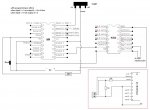Hi,
I have a board called a USB 2040 interface, it's a flight-sim thing that gives you two rows of pins and by connecting a push button across 2 pins and closing it it makes the computer think a button such as the trigger on a joystick has been pressed (which can then be set to control some function in the flight sim). Anyway what I want to do is use toggle switches across these pins; problem is when the switch is thrown the computer will see this as 1 continuous button press. So I want to use a picaxe chip so that when the toggle switch is thrown only a pulse of say 0.5sec is sent out, so across the 2pins it just seems like a button press.
I want to do this with 10 toggle switches. My plan is to use 2x 18M chips (with 5 toggles on each chip) as I already have this starter kit I can just replace the current 18M with a new chip and download the programme to it before taking it out to use with the toggles.
Can I do what is shown in the attached picture? (Expertidly done in paint)
Or will I need to use relays? (Please bear in mind im very new it picaxe/ICs)
Manys thanks,
Rob
I have a board called a USB 2040 interface, it's a flight-sim thing that gives you two rows of pins and by connecting a push button across 2 pins and closing it it makes the computer think a button such as the trigger on a joystick has been pressed (which can then be set to control some function in the flight sim). Anyway what I want to do is use toggle switches across these pins; problem is when the switch is thrown the computer will see this as 1 continuous button press. So I want to use a picaxe chip so that when the toggle switch is thrown only a pulse of say 0.5sec is sent out, so across the 2pins it just seems like a button press.
I want to do this with 10 toggle switches. My plan is to use 2x 18M chips (with 5 toggles on each chip) as I already have this starter kit I can just replace the current 18M with a new chip and download the programme to it before taking it out to use with the toggles.
Can I do what is shown in the attached picture? (Expertidly done in paint)
Or will I need to use relays? (Please bear in mind im very new it picaxe/ICs)
Manys thanks,
Rob
Attachments
-
16.4 KB Views: 46




